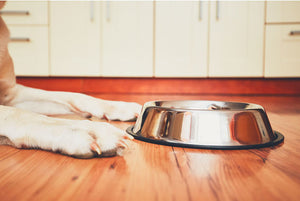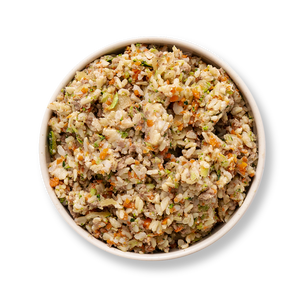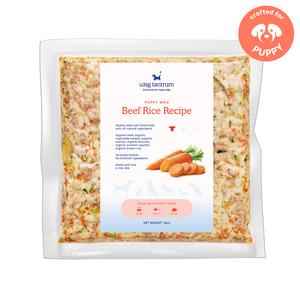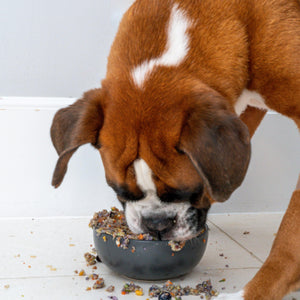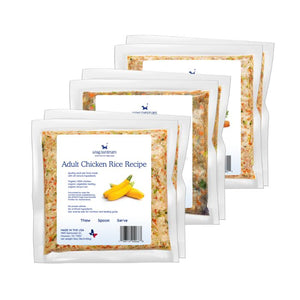Do Dogs Need Gluten-Free Dog Food?
These days, you’ll find gluten-free options everywhere, including gluten free dog food. While a gluten-free diet can be a good option to consider, it’s not the only factor to take into account when selecting dog food. Let’s take a look at gluten and how it can affect your furry friend.

What is Gluten?
Gluten is a type of protein and it’s found naturally in some grains including wheat, rye and barley. Some oats also contain trace amounts of gluten if they are processed in facilities that also process wheat or another glutenous grain.
Gluten also is sometimes extracted from these grains and used in processed foods as a binding agent, and also sometimes gluten is added to products to increase the protein content or improve the texture of a product.
Can Dogs Digest Gluten?
Humans and dogs digest gluten using an enzyme called protease, which breaks down gluten. Dogs and humans also have two other types of digestive enzymes, including amylases, which digest carbohydrates and lipases which digest fat, but we digress.
Many dogs and humans have no trouble digesting gluten, but for some people and their furry companions, eating gluten triggers an autoimmune response whenever they eat foods containing this protein, which is a condition known as celiac disease. This can cause severe abdominal pain, nausea, vomiting, constipation and diarrhea. In some cases, the damage caused by ingesting gluten is irreversible.
While people and dogs with celiac disease should always avoid foods that contain gluten, there are some animals and humans that also seem to have some gluten sensitivity and while their reactions to ingesting gluten aren’t as severe, they do often suffer from abdominal distress and other issues.
In general, most dogs don't have a problem with gluten, but if your dog seems prone to stomach issues, skin issues, chronic ear infections or perhaps inflammatory issues such as arthritis, it may be wise to switch to gluten-free dog food as gluten may be the culprit.
What About Grain-Free Dog Food?
There are quite a few gluten and grain-free dog foods on the market, and while we hear a lot about how dogs in the wild didn’t eat grains, our dog companions are modern, domesticated animals that don’t have to scavenge for their food. Therefore, we can feed them a healthy mix of proteins, fats and carbohydrates, and that can include healthy grains.
Most dog foods contain some type of grain, and most dogs are not allergic to these grains. However, in many dog foods, the grain sources themselves, while not usually allergenic, tend to be cheap fillers with little nutritional value, such as corn or soy. In some cases, wheat is used, which can be a problem for dogs with celiac disease or gluten sensitivity.
In general, you don’t really need to worry about providing them with a grain-free and gluten-free diet. Rather than eliminate all grains from your dog’s diet, it can be better to opt for dog food that contains healthy, gluten-free grains, such as brown rice and quinoa, which is what we use in Wag Tantrum. We chose these two grains specifically for their high nutritional value and because they are gluten-free.
The Best Option – High-Quality, Limited Ingredient Dog Food
Grab a can of typical dog food or a bag of kibble and you will see a long list of ingredients, with many substances that you can’t even pronounce. The source of proteins are typically scrap meats, sometimes even from diseased animals. The carbohydrate sources are cheap fillers. The food also is filled with chemicals and preservatives.
Humans are encouraged to eat a diet of whole, fresh foods and avoid heavily processed foods and that’s just as important for our dogs. Choosing an organic, fresh dog food can be a better option for many reasons.
Fresh dog food tends to have very few ingredients, and each ingredient is selected based on its nutritional value. For instance, with our product line, there are two protein options – USDA organic chicken or USDA organic beef and two grain options – organic brown rice and organic quinoa. Additional ingredients may include broccoli, brussels sprouts, blueberries, butternut squash and carrots, all of which are organic. And that’s it. No fillers, no preservatives, no chemicals.
We chose these ingredients for their nutritional value and because they are easy for dogs to digest. Sticking with a simple yet nutritionally complete diet with wholesome organic ingredients is the best option for most dogs.
After each small batch of our human-grade dog food is cooked, we add a carefully selected mix of pharma-grade vitamins and minerals to the batch and quickly freeze the food to maintain quality.
Whether you select our organic gluten-free dog food or another brand, we encourage all dog parents to look carefully at the ingredient list. If the food (or your dog treats) contains any of the following ingredients, consider opting for another brand:
- Wheat
- Soy
- Corn
- Pea Protein
- Meat Meal (or just the generic term “meat” or “animal byproducts”)
- Bone Meal
- Salt
- Corn Syrup
- Nitrates & Nitrites
- Sodium Tripolyphosphate
- Propylene Glycol
- BHA & BHT
- Artificial Colors & Flavors
We’ve already discussed the issues with cheap fillers such as corn and soy, as well as potential gluten issues with wheat. Peas on their own can be healthy for dogs, but pea protein often is used as a cheap source of protein rather than using quality meat and pea protein doesn’t contain all of the amino acids that our dogs need, while meats such as beef and poultry do.
When it comes to the “meat” protein in many dog foods, it’s best to select foods that include human-grade cuts of beef, poultry or other animal-based protein sources. Only certain brands of fresh dog food (including Wag Tantrum) can be categorized as human-grade dog food.
While some kibble and canned dog food brands do use fairly high-quality ingredients, they typically do not include human-grade meats. Instead, they use what remains on the animal after the meat fit for human consumption has been removed. For instance, a food with chicken meal listed as an ingredient might contain skin, bones, intestines and other non-desirable scraps. In some cases, the meat or poultry comes from diseased animals.
Ingredients such as salt and corn syrup or any type of sweeteners are not good for dogs and are not necessary for their diet. The many chemicals listed above such as BHA, nitrates and propylene glycol are used in canned pet food and kibble as preservatives, but these chemicals do nothing to enhance your dog’s diet and it’s best to simply avoid food with a bunch of preservatives and artificial additives.
Get Started With Wag Tantrum!

At Wag Tantrum, we make it easy to provide your dog with nutritious gluten-free dog food. We ship our organic dog food right to your front door, and with our subscription service, food is always there when you need it. You can choose to have food sent every two weeks or every four, six or eight weeks, depending on your needs. To get started, just click on the Order Now tab at the top of this page, and if you have any questions, please don’t hesitate to contact us at any time.

